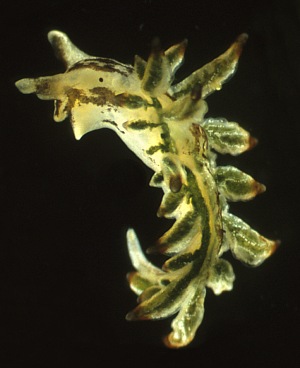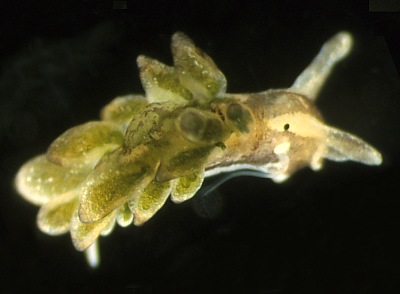
Aplysiopis toyamana
(Baba, 1959)
Order: SACOGLOSSA
Superfamily: LIMAPONTIOIDEA
Family: Hermaeidae
PHOTO
Hokkaido, Japan, on filamentous green algae (Cladophora and Chaetomorpha). Photo: Yoshi Hirano.
Rhinophores auriculate, oral tentacles lobiform and foot corners rounded. Cerata are arranged in about 13 oblique rows with 2-3 cerata in each row. The inside of each ceras has a leaf-like pattern of weakly ridged veins. There is a black median band on the body which passes on to the head. The cerata are green with black tips. Baba compares this species with his A. orientalis (Baba, 1949) but considers they are different - A. orientalis having brown not black markings, and much stronger venation on the cerata.
References:
• Baba, K (1949) Opisthobranchia of Sagami Bay collected by His Majesty The Emperor of Japan. Iwanami Shoyen, Tokyo. 194pp.
• Baba, K. (1959) The family Stiligeridae from Japan (Opisthobranchia- Sacoglossa). Publications of the Seto Marine Biological Laboratory, 7: 327-334.
Rudman, W.B., 2002 (June 19) Aplysiopis toyamana (Baba, 1959). [In] Sea Slug Forum. Australian Museum, Sydney. Available from http://www.seaslugforum.net/find/aplytoya
Related messages
Re: More Japanese sacoglossans
June 21, 2002
From: Kathe R. Jensen
Dear Cynthia & Bill,
The photos are of a species of Aplysiopsis, and my guess is that it is A. toyamana (Baba, 1959) or A. orientalis (Baba, 1949) - both originally described as Hermaeina. On the lower photo you can see the branched vessels on the inner surface of the cerata. Also, some cerata seem to have dark tips, which has been described in both species. The median pigmented band on the head has also been described for these two species - brown in A. orientalis and black in A. toyamana. Supposedly the branching vessels on the cerata of A. toyamana are more indistinct and less ramified than in A. orientalis, but this I cannot really distinguish on the photos. The rolled rhinophores have the typical aspect of one flap being shorter than the other.
Cheers,
Kathe
jensen@ait.ac.th
Jensen, K.R., 2002 (Jun 21) Re: More Japanese sacoglossans. [Message in] Sea Slug Forum. Australian Museum, Sydney. Available from http://www.seaslugforum.net/find/7322Thanks Kathe,
Having looked at the two descriptions I can see your dilemma. What we don't know is whether the brown in the painting of A. orientalis and in Baba's description, is variable within the species. Some browns in opisthobranchs seem interchangeable with black. Since we don't know I guess the safest course is to identify this animal with Aplysiopsis toyamana (Baba, 1959), with which it fits quite well. Clearly this is another sacoglossan species which needs more sampling.
Best wishes,
Bill Rudman
More Japanese sacoglossans
June 19, 2002
From: Cynthia Trowbridge


Dear Bill,
Your recent message about Hermaea reminded me about two species that I found with the Hiranos in July 2001 at various locations around southern Hokkaido. Yoshi Hirano kindly photographed these slugs found on filamentous green algae (Cladophora and Chaetomorpha). The slugs were intertidal to shallow subtidal (< 1m). From the field populations, I am pretty certain that these were 2 separate species. I would welcome your thoughts about these slugs. The wealth of species on Japanese shores is an exciting challenge.
All the best,
Cordially,
Cynthia
trowbric@onid.orst.edu
Trowbridge, C., 2002 (Jun 19) More Japanese sacoglossans. [Message in] Sea Slug Forum. Australian Museum, Sydney. Available from http://www.seaslugforum.net/find/7023Thanks Cynthia,
There does seem to be an amazing diversity of sacoglossans in Japan. Perhaps I will wait and see what Kathe has to say about these photos
Best wishes,
Bill Rudman
